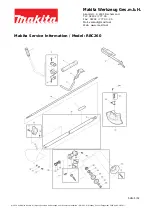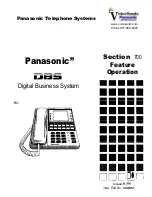
Example: Setting of CH1
1. b0 Reserved
2. b1 Reserved
3. b2: Set to 1 and PLC will be reset to factory settings.
Definition of ERR LED: b12~b15=1111(factory settings)
1. b12 corresponds to CH1: when b12=1, scale exceeds the range, ERR LED
flashes.
2. b13 corresponds to CH2: when b13=1, scale exceeds the range, ERR LED
flashes.
3. b14 corresponds to CH3: when b14=1, scale exceeds the range, ERR LED
flashes.
4.
b15 corresponds to CH4: when b15=1, scale exceeds the range, ERR LED
flashes.
#34 H 40B4
○
R
Software version
Display software version in hexadecimal. Example: H 010A = version 1.0A.
#35~#48
System used
○
means latched.
╳
means not latched.
R means can read data by using FROM command or RS-485.
W means can write data by using TO command or RS-485.
Explanation:
1.
CR#0: The PLC model type.
2.
CR#1: Used to set the working mode of four channels (CH1~CH4). There are 2 modes (J-type and K-type)
for each channel and allow to set separately. For example, If you want to set CH1~CH4 as CH1: mode 0
(b2~b0=000), CH2: mode 1(b5~b3=001), CH3: mode 0(b8~b6=000) and CH4: mode 1(b11~b9=001), you
should set CR#1 to H0208. The higher bits (b12~b15) will be reserved and the factory setting is H0000.
3.
CR#2 ~ CR#5: Used to set the number of input readings used for the average temperature calculation. The
available range is K1~K4096 and factory setting is K10. (Note: When PLC sets average times via TO/DTO
instructions, please use rising-edge/falling-edge detection instruction (such as LDP and LDF) to get correct
average times.)
4.
CR#6 ~ CR#9: The average temperature (
°
C). The average temperature is calculated using multiple
temperature readings. Example: If CR#2 is 10, the temperature in CR#6 will be the average of the last 10
readings on CH1.
5.
CR#10 ~ CR#13: The average temperature (
°
C). The average temperature is calculated using multiple
temperature readings. Example: If CR#2 is 10, the temperature in CR#12 will be the average of the last
10 readings on CH1.
6.
CR#14 ~ CR#17: display present temperature (
°
C) of CH1~CH4 input signal.
7.
CR#18, CR#23, CR#28, CR#29 are reserved.
8.
CR#19 ~ CR#22: display present temperature (
°
F) of CH1~CH4 input signal.
9.
CR #24 ~ CR #27: display offset value of channels CH1~CH4. The range is -1000~+1000 and unit is 0.1
degrees C. The definition of OFFSET is Actual temperature = temperature measured by DVP-04TC –
OFFSET value.
10.
CR#30 is a fault code register. Refer to the following chart.
Fault description
Content
b15~b8
b7
b6
b5
b4
b3
b2
b1
b0
Power source abnormal
K1(H1)
Reserved
0
0
0
0
0
0
0
1
Analog input value error
K2(H2)
0
0
0
0
0
0
1
0
Setting mode error
K4(H4)
0
0
0
0
0
1
0
0
Offset/Gain error
K8(H8)
0
0
0
0
1
0
0
0
Hardware malfunction
K16(H10)
0
0
0
1
0
0
0
0
Digital range error
K32(H20)
0
0
1
0
0
0
0
0
Average times setting error
K64(H40)
0
1
0
0
0
0
0
0
Command error
K128(H80)
1
0
0
0
0
0
0
0
Note: Each fault code will have corresponding bit (b0~b7). Two or more faults may happen at the same time. 0
means normal and 1 means fault occurs.
11.
CR#31: RS-485 communication address. Setting range is 01~255 and factory setting is K1.
12.
CR#32: RS-485 communication baud rate: 4800, 9600, 19200, 38400, 57600 and 115200. b0:4800bps,
b1:9600bps (factory setting), b2:19200bps, b3:38400 bps, b4:57600 bps, b5:115200 bps, b6~b13:
Reserved, b14: switch between low bit and high bit of CRC code (only for RTU mode) b15: ASCII / RTU
mode. For ASCII mode, date format is 7Bits, even, 1 stop bit (7 E 1). For RTU mode, date format is 8Bits,
even, 1 stop bit (8 E 1).
13.
CR#33: Used to reset the settings of CR registers to factory defaults.
14.
CR#34: software version.
15.
CR#35~ CR#48: Reserved for internal system use.
16.
The corresponding parameters address H 4096~H 40C7 of CR#0~CR#48 may provide users to read/write
data via RS-485 communication.
a)
Communication baud rate: 4800, 9600, 19200, 38400, 57600, 115200 bps.
b)
Communication format: ASCII mode is 7Bit, even bit, 1 stop bit (7 E 1). Communication format of
RTU mode is 8Bit, even bit, 1 stop bit (8 E 1).
c)
Function code: 03H—read data from register. 06H—write a WORD into register. 10H—write many
WORDs into register.
5
TEMPERATURE/DIGITAL CHARACTERISTIC CURVE
Temperature mode: (Centigrade/Fahrenheit)
J-type thermocouple sensors
+7000(12920)
-1000(-1480)
+700
-100
Digital Output
Temperature Input
C
C
F)
(-148
F)
(+1292
K-type thermocouple sensors
+10000(18320)
-1000(-1480)
+1000
-100 C
C
Temperature Input
Digital Output
(-148 F)
(-1832 F)
R/S-type thermocouple sensors
+17000(30920)
-100(-140)
+1700
-10
Digital Output
Temperature Input
C
C
F)
(-14
F)
(+3092
T-type thermocouple sensors
+3500(6620)
-1000(-1480)
+350
-100
Digital Output
Temperature Input
C
C
F)
(-148
F)
(+662
6
INITIAL PLC START-UP
LED display:
1. Upon power-up, the ERROR LED will light for 0.5 seconds the POWER LED will light continuously.
2. No errors= POWER LED on and ERROR LED off.
Low Voltage error (lower than 19.5V), ERROR LED will blink continuously till the power supply rises above
19.5V.
3. DVP04TC-S connected to PLC MPU in series = RUN LED on MPU will be lit and A/D LED or D/A LED should
blink.
4. After receiving the first RS-485 command the A/D LED or D/A LED will blink.
5. If the input or output exceeds the upper or lower bounds, then the ERROR LED will blink.
Example:
M1000
FROM
K0
= H8B D0
TO
K0
FROM
K0
FROM
K0
FROM
K0
FROM
K0
END
M1002
Explanation:
Reading the model type of expansion module K0 (should be H8B for DVP04TC-S model type).
The averaging number for CH1~CH4 will be D10~D13.
If the model type is DVP04TC-S. Reading the average temperature (
°
C) of CH1~CH4 (4 data) from
CR#6~CR#9 and save them into D20~D23.
Reading the average temperature (
°
F) of CH1~CH4 (4 data) from CR#10~CR#13 and save them into
D24~D27.
Reading the present temperature (
°
C) of CH1~CH4 (4 data) from CR#14~CR#17 and save them into
D30~D33.
Reading the present temperature (
°
F) of CH1~CH4 (4 data) from CR#19~CR#22 and save them into D34~D37.
7
RELATED INSTRUCTIONS EXPLANATION
API
F R O M
Read special module CR data
78
D
P
Explanations:
m1
: number of special module (m1=0~7).
m2
: CR number of special module that will be read.
D
: address for saving
reading data.
n
: data number for reading once.
Example:
Writing special module #0 of CR#24 into D0 and special module #0 of CR#25 into D1. only write two data once
(n=2).
X10
FROM
K0
K24
D0
K2
API
T O
Special module CR data write
79
D
P
Explanations:
m1
: number of special module (m1=0~7).
m2
: CR number of special module that will be wrote in.
S
: data to write in
CR.
n
: data number to write in once.
Example:
Using 32-bit instruction DTO to write D11 and D10 into special module#0 of CR#3 and CR#2. only write a data once
(n=1).
X11
DTO
K0
K2
D10
K1
The rule of instruction operand:
1.
m1: number of special module. The special module closest to the ELC controller will be assigned 0, the next
closest will be assigned 1, etc. for a total of 8 modules(0~7).
2.
m2: number of CR. Built-in of 48 groups of 16-bit memory of special module are called CR (Control Register).
Each CR uses decimal digits (#0~#48).
CR #10
CR #9
Upper 16-bit Lower 16-bit
Specified CR number
D0
D1
D2
D3
D4
D5
CR #5
CR #6
CR #7
CR #8
CR #9
CR #10
D0
D1
D2
D3
D4
D5
CR #5
CR #6
CR #7
CR #8
CR #9
CR #10
Specified device
Specified CR
Specified device Specified CR
16-bit command when n=6
32-bit command when n=3
3.
In PB models, flag M1083 is not provided. When the FROM/TO instruction is executed, all interrupts (including
external or internal interrupt subroutines) will be disabled. All interrupts will be executed after the FROM/TO
instruction is completed. The, FROM/TO instruction can also be executed in an interrupt subroutine.
4.
The function of the flag M1083 (FROM/TO mode) provided in PC/PA/PH models:
a.
When M1083=OFF, FROM/TO instruction is executed, all interrupts (including external or internal
interrupt subroutines) will be disabled. All interrupts will be executed after FROM/TO instruction is
completed.
b.
When M1083=ON, if an interrupt occurs while the FROM/TO instruction has been programmed, The
FROM/TO instruction will be interrupted to execute the interrupt. The FROM/TO instruction cannot be
executed in the interrupt subroutine.




















